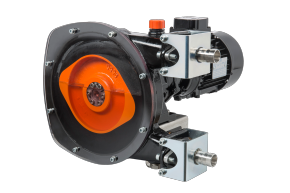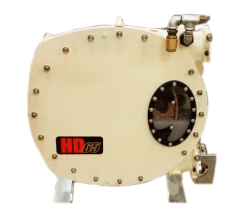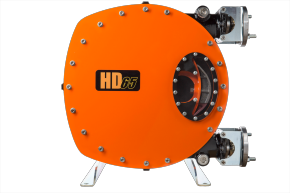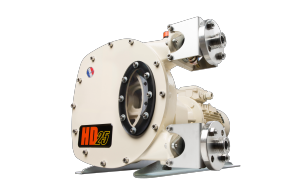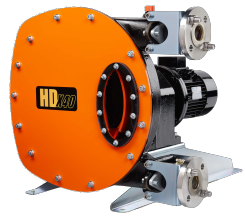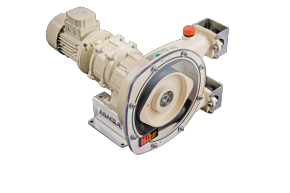Hose pumps, also known as hose squeeze pumps and peristaltic pumps are self-priming positive displacement pumps that are safe to run dry. One of the biggest advantages of the peristaltic pumps is the robust, low-maintenance construction without valves. The hose is the only component that comes into contact with the medium. Peristaltic pumps convey and dose liquids, including solids, gently and reliably. This is the major difference and design advantage compared to other positive displacement pump types. The simplicity of the hose pump provides a number of advantages. The hose can be made from any of a variety of materials. Wearing of the pump is virtually limited to the hose, which is quick and inexpensive to replace.



Peristaltic Pumps
7 series from 2 manufacturers
-
- Adhesives
- Agriculture
- Bakery and confectionery
- Beauty & Personal Care
- Brewing and beverages
- Chemical
- Convenience food
- Dairy
- Detergents
- Distilleries
- Drinking Water
- Fish Farming
- Food & Beverage
- Heating, Water & Sanitation
- Meat Processing
- Oil & Gas
- Oil Fats & Mayonnaise
- Paint & Surface Coating
- Paper Mills
- Petrochemical
- Pharmaceutical
- Plastic
- Research & Development
- Surface Finishing
- Textile
- Wastewater
- Water Treatment
-
- Analysis
- Booster
- Circulation
- Cleaning
- Control
- Cooling
- Descaling
- Desinfection
- Dewatering
- Diagnostic
- Distribution
- Dosing
- Drain
- Dual Dispensing
- Extraction
- Feed
- Filling
- Filtration
- Flow Control
- Greasing
- Heating
- High-Temperature
- Injection
- Irrigation
- Level Control
- Low-Pressure
- Lubrication
- Medium-Pressure
- Metering
- Mixing
- Powder Coating
- Process
- Processing
- Recovery
- Sampling
- Tempering
- Transfer
- Treatment
- Washing
- Water-Jet Cleaning
-
- Abrasive Liquids
- Acetate
- Acids
- Adhesives
- Alcohols
- Aluminium Oxide Slurry
- Ammonia
- Beer
- Carbon Fibers
- Caustic Solutions
- Cereals
- China Clay Slurry
- CIP Fluids
- Coffee
- Corrosive Dyes
- Crystalline Slurry
- Dairy Products
- Detergents
- Diesel Fuel Oil
- Dye Pigment
- Emulsions
- Ethylene Glycol
- Ferric Chloride
- Fertilizers
- Foam Protein
- Gels
- Hydrochloric Acid
- Hygienic Liquids
- Lime
- Low NPSH
- Low Viscosity Liquids
- Milk
- Molasses and Syrups
- Non-Newtonian Fluids
- Paints
- Paints Resins
- Personal Care Products
- Phosphoric Acid
- Produced Water
- Redox
- Sensitive and Viscous Fluids
- Sewage
- Silver Nitrate
- Soaps and Detergents
- Solids and Abrasives
- Solvents
- Spirits
- Sulphuric Acids
- Surface Water
- Synthetic Fibers
- Thixotropic Fluids
- Toxic Liquids
- Vegetable Oils
- Vinegar
- Viscose
- Viscous Liquids
- Wastewater
- Water
- Water Hardness
- Wine
-
- Abrasion Resistant
- Adjustable-Flow
- Automatic
- Chemically Resistant
- CIP
- Close-Coupled
- Compact
- Corrosion-Proof
- Direct-Drive
- Double-Acting
- Electric
- Explosion-Proof
- Fish Friendly
- Heavy-Duty
- High Temperature
- High-Efficiency
- Horizontal Mount
- Intrinsically Safe
- Low Shear
- Low-Noise
- Mechanical
- Mixed Flow
- Modular
- Non-Metal
- Oil-Free
- Sanitary
- Seal-less
- Self-priming
- SIP
- Solids Handling
- Variable Speed
HOW DOES A PERISTALTIC PUMP WORK?
Peristaltic pumps work according to the peristaltic principle. The hose, as the central component in the pump, is compressed by sliding shoes or rollers that are attached to a rotor and moved over the hose. The pinched spot moves along the tube, and the contained liquid is pushed forward. After compression, the restoring forces of the high-strength hose ensure that it opens back into its original shape. This creates a strong negative pressure, which supplies more liquid from the line.
Peristaltic pumps are a pre-training pump and work according to the peristaltic principle. The hose, which can consist of a variety of materials, is paced in the pump housing. The pump rotor exerts pressure when it rotates on a set of rollers or pressure jaws which, in turn, compress the hose. This creates a vacuum behind the roller or pressure jaw that sucks in liquid in the hose while the next roller or pressure jaw gently pushes the liquid forward through the hose.The only wear part of the pump is the hose which can be quickly and economically replaced on site.
The hose, as the central component of the pump, is compressed by pressure jaws or rollers attached to a rotor and moved over the hose. The pinched spot moves along the tube and the entrapped liquid is pushed forward. After compression, restorative forces from the high-strength hose ensure that it opens back to its original shape. This creates a strong negative pressure, which adds more fluid from the pipe.
IN WHICH APPLICATIONS ARE PERISTALTIC PUMPS USED?
- Peristaltic pumps are the first choice for metering and pumping liquids in many different industries.
- Some peristaltic pumps can meter abrasive liquid mixtures such as milk of lime, ferric chloride and other flocculants in water treatment plants.
- High-pressure hose pumps are used to feed filter presses in sewage treatment plants in order to dewater the sewage sludge.
- Peristaltic pumps with hygiene certification meter colorants, flavors, dairy products and shear-sensitive media in food production.
WHY BUY PERISTALTIC PUMPS FROM AXFLOW
This is the major difference and design advantage compared to other positive displacement pump types. The simplicity of the hose pump provides a number of advantages. The hose can be made from any of a variety of materials. Wearing of the pump is virtually limited to the hose, which is quick and inexpensive to replace.
REPLACEMENT PARTS AND SERVICE FOR PERISTALTIC PUMPS
Replacement hoses for peristaltic pumps are available in many materials for different pumped media and in different sizes. A large selection of hoses, components and entire pumps are available directly from our European central warehouse with short delivery times. Our service technicians are happy to adapt the connections and base dimensions to your system and are also available for maintenance and repair work afterwards
